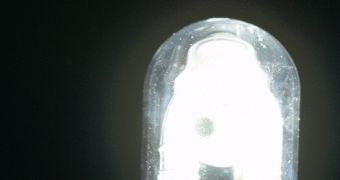Flash tubes are electric glow discharge lamps able to produce high intensity, incoherent, full white light spectrum bursts for small amounts of time. Flash tubes are generally used as high intensity light sources in photographic cameras, warning lights on emergency vehicles and anti-collision beacons and even as light pumps for monochromatic lasers.
Their construction is rather similar to that of fluorescent tubes, however the operation is slightly more complex. A typical flash tube is constructed of a transparent envelope, usually made of glass, shaped into a linear tube or a horseshoe-like structure. Each end of the tube bears a single electrode through which high voltage electrical current is being pumped. Additionally, the tube also holds a high voltage trigger having the role of initiating an electrical discharge through the working gas, xenon.
How it works
First, the xenon gas is being ionized after which a large pulse of current is sent to the electrodes and through the gas mass. The electrical resistance of gases is usually very large, meaning that after the ionzation has occurred, the following pulse of current discharging through the gas could reach several thousand of amperes. Ionization is initiated with the help of a Tesla coil, by sending a short high voltage current to the electrodes.
The cathode starts producing ions which would never reach the anode if it weren't capacitively linked to the cathode. This is done by applying a conductive strip inside the glass envelope, by putting a metal band around the envelope in the vicinity of the two electrodes or by submerging the flash tube in water.
Depending on the length of the tube, xenon pressure inside the envelope may range between 0.01 and 0.1 atmospheres. When the large high voltage current is being discharged through the xenon gas, electrons inside the atoms jump to higher energy levels. As the discharge stops, the atoms become unstable and the electrons jump back to lower orbitals. Before doing so, energy must be ejected in the form of photon particles.
Light output
You're probably wondering why xenon gas instead of neon? Xenon gas is amongst the few chemical elements which are able to emit light in various spectral lines, giving the appearance of white light emissions only. In fact, xenon emits light mostly in the wavelengths of light associated with the color green. Neon, on the other hand, presents a spectral line emission which gives it its characteristic reddish light, while krypton for example emits a great deal of light in the near-infrared wavelengths.
Light burst duration is limited by the number of the electrons emitted by the cathode, and is usually situated between a few microseconds and several milliseconds. The pulse of light may repeat itself with a frequency of several hundred hertz.

 14 DAY TRIAL //
14 DAY TRIAL //